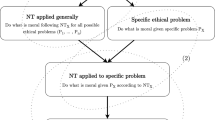Abstract
In the spatialized Prisoner's Dilemma, players compete against their immediate neighbors and adopt a neighbor's strategy should it prove locally superior. Fields of strategies evolve in the manner of cellular automata (Nowak and May, 1993; Mar and St. Denis, 1993a,b; Grim 1995, 1996). Often a question arises as to what the eventual outcome of an initial spatial configuration of strategies will be: Will a single strategy prove triumphant in the sense of progressively conquering more and more territory without opposition, or will an equilibrium of some small number of strategies emerge? Here it is shown, for finite configurations of Prisoner's Dilemma strategies embedded in a given infinite background, that such questions are formally undecidable: there is no algorithm or effective procedure which, given a specification of a finite configuration, will in all cases tell us whether that configuration will or will not result in progressive conquest by a single strategy when embedded in the given field. The proof introduces undecidability into decision theory in three steps: by (1) outlining a class of abstract machines with familiar undecidability results, by (2) modelling these machines within a particular family of cellular automata, carrying over undecidability results for these, and finally by (3) showing that spatial configurations of Prisoner's Dilemma strategies will take the form of such cellular automata.
Similar content being viewed by others
REFERENCES
Axelrod, R.: 1984, The Evolution of Cooperation, Basic Books, New York.
Berlekamp, E., Conway, J., and Guy, R.: 1982, Winning Ways for your Mathematical Plays, Vol. II, Academic Press, London.
Boolos, G., and Jeffrey, R.: 1989, Computability and Logic, Third Edition, Cambridge Univ. Press, New York.
Demongeot, J., Golès, E., and Tchuente, M. (Eds.): 1985, Dynamical Systems and Cellular Automata, Academic Press, New York. Dewdney, A.K.: 1990, 'The cellular automata programs that create wireworld, rugworld and other diversions', Computer Recreactions, Scientific American 262(1), 146-149.
Dewdney, A.K.: 1993, The (New) Turing Omnibus, Computer Science Press, New York.
Grim, P.: 1994a, 'Computation and Undecidability in the Spatialized Prisoner's Dilemma,' Research Report No. 94-02, Group for Logic and Formal Semantics, Dept. of Philosophy, SUNY at Stony Brook.
Grim, P.: 1994b 'An NP-Complete Question Regarding the Spatialized Prisoner's Dilemma,' Research Report No. 94-03, Group for Logic and Formal Semantics, Dept. of Philosophy, SUNY at Stony Brook.
Grim, P.: 1995, 'The Greater Generosity of the Spatialized Prisoner's Dilemma', Journal of Theoretical Biology 173, 353-359.
Grim, P.: 1996, 'Spatialization and greater generosity in the stochastic Prisoner's Dilemma', BioSystems 37, 3-17.
Gutowitz, H. (Ed.): 1990, Cellular Automata: Theory and Experiment, North-Holland, New York.
Mar, G., and St. Denis, P.: 1993a, 'The Evolution of Dynamical Meta-Strategies in the Prisoner's Dilemma', International Conference on Game Theory, SUNY at Stony Brook, July 1993, and research report No. 93-01, Group for Logic and Formal Semantics, Dept. of Philosophy, SUNY at Stony Brook.
Mar, G., and St. Denis, P.: 1993b, 'Chaos in Cooperation: Two-Dimensional Prisoner's Dilemmas in Infinite-Valued Logic,' research report No. 93-02, Group for Logic and Formal Semantics, Dept. of Philosophy, SUNY at Stony Brook, and International Journal of Bifurcation and Chaos 4 (1994), 943-958.
Minsky, M.: 1967, Computation: Finite and Infinite Machines, Prentice-Hall, Englewood Cliffs, N.J.
Nowak, M.: 1990, 'Stochastic Strategies in the Prisoner's Dilemma,' Theoretical Population Biology 38, 93-112.
Nowak, M., and May, R.: 1992, 'Evolutionary games and spatial chaos', Nature 359, 826-829.
Nowak, M., and May, R.: 1993, 'The Spatial Dimensions of Evolution', International Journal of Bifurcation and Chaos 3(1), 35-78.
Nowak, M., and Sigmund, K.: 1989, 'Game-Dynamical Aspects of the Prisoner's Dilemma', Applied Mathematics and Computation 30, 191-213.
Nowak, M., and Sigmund, K.: 1992, 'Tit for tat in heterogeneous populations', Nature 355, 250-252.
Nowak, M., and Sigmund, K.: 1993, 'A strategy of win-stay, lose-shift that out-performs tit-for-tat in the Prisoner's Dilemma game', Nature 364, 56-58.
Silverman, Brian.: 1987, The Phantom Fish Tank: An Ecology of Mind, Logo Computer Systems, Montreal.
Toffoli, T., and Margolus, N.: 1987, Cellular Automata Machines: A New Environment for Modelling, MIT Press, Cambridge, Mass.
Wolfram, S.: 1984, 'Cellular automata as models of complexity', Nature 311, 419-424.
Wolfram, S.: 1986, Theory and Applications of Cellular Automata, World Scientific, Philadelphia.
Author information
Authors and Affiliations
Rights and permissions
About this article
Cite this article
Grim, P. The undecidability of the spatialized prisoner's dilemma. Theory and Decision 42, 53–80 (1997). https://doi.org/10.1023/A:1004959623042
Issue Date:
DOI: https://doi.org/10.1023/A:1004959623042




